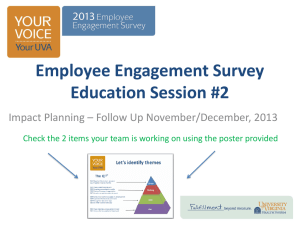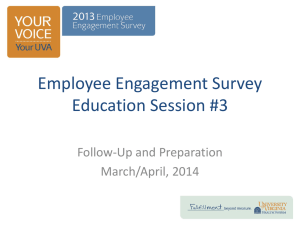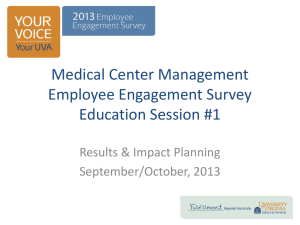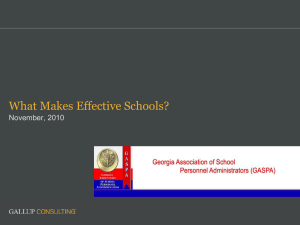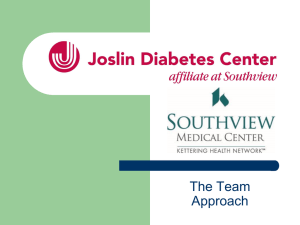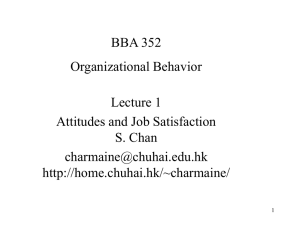From Engagement to Productivity
advertisement
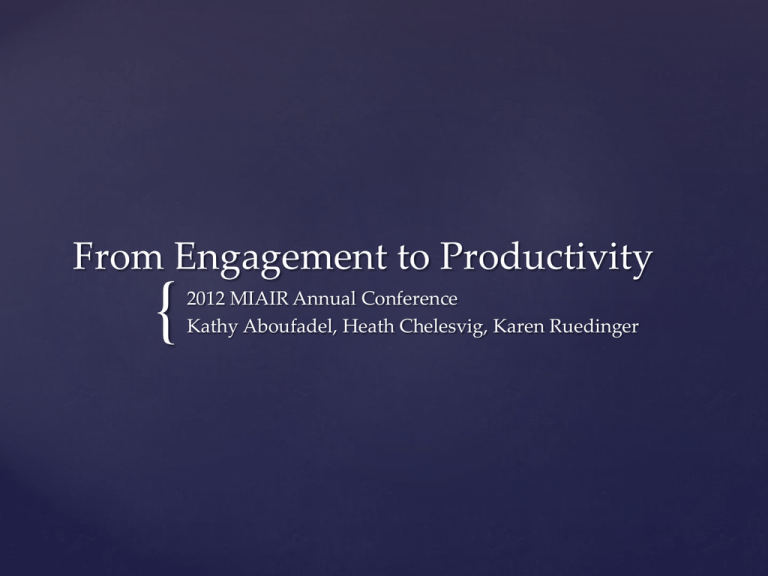
From Engagement to Productivity
{
2012 MIAIR Annual Conference
Kathy Aboufadel, Heath Chelesvig, Karen Ruedinger
Engagement acknowledges and incorporates
the “critical emotional infrastructure of human
behavior and decision-making”1
“The interactive effects of employee and
customer engagement at the local unit level
exponentially drive operational and financial
performance and growth.”1
High engagement yields such benefits as
higher retention, fewer lost work days,
increased productivity, improved safety
The Promise of Engagement
Engaged employees work with passion and feel a
profound connection to their company. They drive
innovation and move the organization forward.
Not-Engaged employees are essentially “checked
out.” They are sleepwalking through their workday.
They are putting in time, but not enough energy or
passion into their work.
Actively Disengaged employees aren’t just unhappy
at work; they’re busy acting out their unhappiness.
Every day, these workers undermine what their
engaged co-workers accomplish.2
Levels of Engagement
According to Gallup’s 2011 Survey3
50% Approximately half of U.S. workers are
not engaged, and
20% Nearly one in five are actively
disengaged, unchanged from late 2010.
That suggests 30% are engaged.
Measuring Engagement
Two main choices:
Utilize a third party instrument
Create a “home grown” instrument
Approaches to Measuring
Engagement
Gallup Q12
PACE
Noel Levitz
Third Party Instruments
Gallup Q12
{
An Overview
The focus of the instrument is measuring what is
most important in attracting and keeping the most
talented employees.
Gallup has forged a connection between the
opinions of employees and the performance of a unit
or department.
The 12 questions were tested in 2,500 business units
with over 105,000 employees and they represent the
fewest variables that distinguish great employees
from those who are average or poor.
In the end, Gallup found that the immediate
supervisor is most critical in helping to foster high
levels of engagement.
Gallup Q12
1.
2.
3.
4.
5.
Do I know what is expected of
me at work?
Do I have the materials and
equipment I need to do my work
right?
At work, do I have the
opportunity to do what I do best
every day?
In the last seven days, have I
received recognition or praise for
doing good work?
Does my supervisor, or someone
at work, seem to care about me
as a person?
Gallup Q12
6.
7.
8.
9.
10.
11.
12.
Is there someone at work who
encourages my development?
At work, do my opinions seem
to count?
Does the mission/purpose of my
company make me feel my job is
important?
Are my co-workers committed to
doing quality work?
Do I have a best friend at work?
In the last six months, has
someone at work talked to me
about my progress?
This last year, have I had
opportunities at work to learn
and grow?
Pros
Rigorous testing of survey results as connected to meaningful and
valued business outcomes.
They calculate an Engagement Ratio which can be tracked for
improvement over time.
They also calculate indices which help measure strengths in different
areas such as: Innovation, Change Management, Customer Orientation,
Leadership and Inclusiveness.
Large database of benchmark data.
Access to Gallup consulting service to connect results to changes in
behavior designed to drive engagement increases in your institution.
Cons
Cost
Relatively few institutions of HE included in their benchmark database.
In 2010 there was no community college data in their database meaning
they had not worked with any CC’s in the prior three years.
Limited ability to customize questions to fit your institution.
Gallup’s interest is less in administering the survey and more in
providing post-survey consulting working directly with supervisors to
create change.
Gallup Q12
PACE
{
Grand Rapids Community College
PACE
The purpose of the PACE instrument is to
promote open and constructive communication
and to establish priorities for change by
obtaining the satisfaction estimate of
employees concerning the campus climate.
Items on this instrument are divided into four
domains:
Institutional structure
Supervisory relationship
Teamwork, and student focus
Measures satisfaction
http://ncsu.qualtrics.com//SE/?SID=SV_cPeLmS503bYpUDG
PACE
Pros
Cons
PACE
Cost $4500
Custom Questions/Reports available
Pretty Quick Turn-around
Limited number of custom questions (10 allowed
plus demographic data)
Only open-ended question for overall
impressions
Data lag – hard to match our planning cycle
Using for Quality Initiatives – MQA, AQIP and
Baldridge
Conducted Focus Groups to get feedback on
lowest rated items
Leadership used to create Department Action
Projects
Example – Diversity Initiative sparked by
PACE results
Grand Rapids CC’s Experience
Noel Levitz
{
Davenport University
Their tool is called the College Employee Satisfaction
Survey™. It allows you to assess campus culture,
work environment, mission, and more.
With the data from this survey, you can:
See which issues are most important to your campus
employees
Assess their attitudes toward your institutional
mission and goals
Uncover key data about the work environment on
campus
Compare to other institutions of higher education
Provides a complete set of summary tables. In
addition, you may order raw data, segmented tables,
and other options for further analysis.
Noel Levitz
Includes items in five areas:
1. Campus culture and policies
2. Institutional goals
Employees rate the importance of a variety of institutional goals,
including recruitment, retention, diversity efforts, staff morale,
and more.
Respondents also list which goals should be the top three
campus priorities.
3. Involvement in planning and decision making
Employees rate how much involvement various campus
constituents have in the decision-making process, from not
enough involvement to too much involvement.
4. Work environment
Information flow, Employee empowerment, Supervisor
relationships , Professional development
5. Demographics
Polls overall satisfaction, as well as length of employment and
type of position.
Noel Levitz
2012 Employee Satisfaction Questions
Overall Satisfaction
Rate your overall satisfaction with your employment here so far
Campus Culture and Policies
This institution promotes excellent employee-student relationships
This institution treats students as its top priority
This institution does a good job of meeting the needs of students
The mission, purpose, and values of this institution are well understood by most employees
Most employees are generally supportive of the mission, purpose, and values of institution
The goals and objectives of this institution are consistent with its mission and values
This institution involves its employees in planning for the future
This institution plans carefully
The leadership of this institution has a clear sense of purpose
This institution does a good job of meeting the needs of its faculty
This institution does a good job of meeting the needs of staff
This institution does a good job of meeting the needs of administrators
This institution makes sufficient budgetary resources available to achieve important objectives
This institution makes sufficient staff resources available to achieve important objectives
There are effective lines of communication between departments
Administrators share information regularly with faculty and staff
There is good communication between the faculty and the administration at this institution
There is good communication between staff and the administration at this institution
Faculty take pride in their work
Staff take pride in their work
Administrators take pride in their work
There is a spirit of teamwork and cooperation at this institution
The reputation of this institution continues to improve
This institution is well-respected in the community
Noel Levitz
Specific Measure
Overall
Specific Measure
Student-related
Student-related
Student-related
Mission, Vision, Values
Mission, Vision, Values
Mission, Vision, Values
Planning
Planning
Planning
Meeting needs
Meeting needs
Meeting needs
Budget & resources
Budget & resources
Communications
Communications
Communications
Communications
Pride in work
Pride in work
Pride in work
Pride in work
Reputation
Reputation
2012 Employee Satisfaction Questions (continued)
Efforts to improve quality are paying off at this institution
Employee suggestions are used to improve our institution
This institution consistently follows clear processes for selecting new employees
Consistently follows clear processes for orienting and training new employees
Consistently follows clear processes for recognizing employee achievements
Has written procedures that define who is responsible for each operation and service
Work Environment
It is easy for me to get information at this institution
I learn about important campus events in a timely manner
I am empowered to resolve problems quickly
I am comfortable answering student questions about policies and procedures
I have the information I need to do my job well
My job responsibilities are communicated clearly to me
My supervisor pays attention to what I have to say
My supervisor helps me improve my job performance
My department or work unit has written, up-to-date objectives
My department meets as a team to plan and coordinate work
My department has the budget needed to do its job well
My department has the staff needed to do its job well
I am paid fairly for the work I do
The employee benefits available to me are valuable
I have adequate opportunities for advancement
I have adequate opportunities for training to improve my skills
I have adequate opportunities for professional development
The type of work I do on most days is personally rewarding
The work I do is appreciated by my supervisor
The work I do is valuable to the institution
I am proud to work at this institution
Noel Levitz
Quality & improvement
Quality & improvement
Process improvement
Process improvement
Process improvement
Process improvement
Specific Measure
Culture of quality
Culture of quality
Culture of quality
Culture of quality
Culture of quality
Supervisor satisfaction
Supervisor satisfaction
Supervisor satisfaction
Department-specific
Department-specific
Department-specific
Department-specific
Employee benefits
Employee benefits
Development
Development
Development
Reward & recogition
Reward & recogition
Reward & recogition
Reward & recognition
Four Year Comparison Schools
Antioch University
Black Hills State U
Bluefield State College
Cal State U San Marcos
Canadian Coll Naturopathic Medicine
Caritas Laboure
Davenport University
Friends University
Grantham University
Indiana Institute of Technology
Kettering University
Noel Levitz
Laboure College
National-Louis University
NE Wesleyan
North Central University
Pacific College of Oriental Medicine
Schreiner University
Shenandoah University
Susquehanna
The University of Findlay
Touro University
University of St. Francis
Pros
Access to Higher Education benchmark data
Available in online and paper formats
Designed exclusively for colleges and universities
Can add custom questions
Administration by outside company allows for more anonymity
Cons
Increase price two years in a row; Each additional request costs extra.
Very long survey instrument that includes both satisfaction and
importance ratings
Because we need our data to be comparable, we can’t customize or
tweak questions to fit our environment
The questions are positively-phrased statements that would work
with an agree/disagree scale. However, the scale used is a satisfaction
scale, which doesn't make sense with the phrasing.
Our main contact is an administrative assistant and not a
researcher. This does have its downsides when making special
requests.
Noel Levitz
We moved from an in-house tool two years ago to Noel Levitz. We
found it was one of the few that had decent comparison data to other
institutions.
They had better participation among 2-year institutions than 4-year, so
that would be an advantage.
We have added custom questions so that we have the measures that
we need for our Balanced Scorecard.
73% response rate which is same as when we used internal instrument.
Reporting is basic, so we end up creating our own report using a raw
data file Noel Levitz sends us at an extra charge. They could probably
do a higher level report, but add-ons get quite expensive; and we are
mostly after that comparison data.
We will continue to use this tool because of the comparison data.
Davenport’s Experience
Home Grown
{
Northwestern Michigan College
NMC began surveying employees in 2010.
Investigated other instruments – PACE, Noel Levitz,
Gallup Q12, Noel Levitz, Mercer Management’s tool.
Incorporates six of the Q12 questions in some form.
Provides reporting to managers by departmental
results and to executives by area.
Includes three indices – Engagement, Planning and
Supervisor – which allow for trending over time.
Administered by a third party researcher.
81.4% of regular employees completed the survey in
2012; 65.5% of all employees (including
supplemental and adjunct faculty)
NMC’s Engagement Survey
Engagement at NMC
Pros
Highly cost effective. We pay around $1,200 for
administration of the survey via the web and
coding of open ended responses. The analysis is
done in-house.
High degree of customization of instrument.
Can be administered at any time of the year and
with any desired frequency.
Cons
Lack of benchmark data. HLC would prefer that we
have benchmark data.
No clear connection between the results and
business outcomes.
We are still determining how best to make the
results highly actionable for supervisors.
Engagement at NMC
Significant changing of the questions in the first
two years made it difficult to create a trend
line. Questions are now stable.
Actionable results at the supervisor level are
still a challenge; however measures are
increasingly being connected to A3 operational
plans.
The survey results are informing Action
Projects for continuous improvement.
Looking to administer every two years after
2013.
Lacking benchmark data.
NMC’s Experience
Could we collaborate to develop an employee
engagement survey within Michigan that would
give us the best of both approaches?
Database of benchmark data
Flexibility to create tailored questions to fit each
institution
Cost effective
State-Wide Collaboration
What are some of the challenges to be
overcome?
Is there an institution that would like to take
the lead in setting this up and maintaining the
database of benchmark data?
Who’s interested in forming a workgroup
within MIAIR to investigate this further?
Discussion
1
Manage Your HumanSigma, by John H. Fleming, Ph.D.,
The Gallup Organization, 2005
2 Feedback for Real, by John Thackray, The Gallup
Management Journal
3Engaged Workers Report Twice as Much Job Creation, by
Jim Harter, Gallup Wellbeing, August 9, 2011
Overview of the Gallup Organization’s Q-12 Survey, by
Louis R. Forbringer, Ph.D., O.E. Solutions, Inc., 2002
Sources
